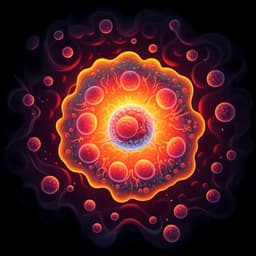
Physics
Motility-induced phase separation is reentrant
J. Su, M. Feng, et al.
Discover the intriguing phenomenon of reentrant motility-induced phase separation in active Brownian particles with pure repulsion, researched by Jie Su, Mengkai Feng, Yunfei Du, Huijun Jiang, and Zhonghuai Hou. This study uncovers how higher activity levels can paradoxically hinder phase separation after initially promoting it, showcasing the fascinating role of nonequilibrium dynamics in active systems.
Playback language: English
Introduction
Active matter, systems of self-propelled units, are ubiquitous in nature, ranging from microscopic bacteria to macroscopic animals. Their ability to consume and dissipate energy to drive themselves far from equilibrium offers unique insights into collective behavior. Active Brownian particles (ABPs), with purely repulsive interactions, are a minimal model for studying these effects. A well-established phenomenon is motility-induced phase separation (MIPS), where activity creates effective attractions leading to phase separation, analogous to the role of temperature in equilibrium systems with attractive interactions. However, the question remains: are there unique phase behaviors in ABPs solely due to their nonequilibrium nature beyond this analogy? This work investigates this question, exploring if the nonequilibrium nature of activity can lead to phase behaviors not observed in equilibrium systems. The researchers hypothesize that activity can induce unique phase behavior, specifically a reentrant MIPS, which is absent in equilibrium systems.
Literature Review
The literature extensively documents MIPS in ABPs. Existing theoretical frameworks, like kinetic theories, effectively describe MIPS by considering activity-induced effective attraction. These theories show that the phase diagram of ABPs resembles equilibrium systems with attractive interactions, with activity replacing inverse temperature. However, these models largely focus on moderate activity regimes. There is a gap in understanding how high activity might affect MIPS. Studies have explored various aspects of active matter, including collective motion, self-assembly, and the influence of different interactions. This study builds upon this foundation, investigating the previously unexplored high-activity regime of purely repulsive ABPs to understand the unique role of nonequilibrium in shaping their phase behavior.
Methodology
The researchers employed both theoretical analysis and numerical simulations. Their theoretical approach starts from a minimal active fluid theory based on a kinetics approach. This framework describes the steady state of phase separation using condensation and evaporation rates (kin and kout, respectively). The condensation rate is proportional to the dilute phase density and self-propulsion velocity, while the evaporation rate is initially modeled as proportional to the rotational diffusion constant, capturing the escape of particles from the dense phase due to rotational diffusion. The steady state condition, kin = kout, yields an expression for the dilute phase density. However, they recognize that at high activity, the diffusion current also becomes significant. This diffusion current is proportional to the density gradient, with the diffusion coefficient potentially dependent on both thermal and activity-induced diffusion, particularly complex in the dense phase. They introduce a phenomenological model to account for this complex diffusion, introducing a fitting parameter λ to represent the combined effect of thermal and activity-induced diffusion in the dense phase. The total current leaving the dense phase is expressed as the sum of diffusion and evaporation terms. By equating the total inflow (condensation) and outflow (evaporation plus diffusion) currents, they derive an expression for the phase boundary showing two transition points, indicating the reentrant behavior. Numerical simulations used a two-dimensional system of ABPs interacting via the Weeks-Chandler-Andersen (WCA) potential, a purely repulsive potential. The ABPs' motion is described by overdamped Langevin equations, including active forces, interaction forces, and noise terms. The simulations utilized dimensionless parameters: the Péclet number (Pe) representing activity and the area fraction (φ) representing density. The simulations tracked the formation of clusters and phase coexistence, allowing for the determination of the phase boundaries (binodal and spinodal). Further simulations investigated the influence of the interaction strength (ε) on the reentrant behavior. This integrated approach combines theoretical modeling and detailed simulations to rigorously explore the phenomenon of reentrant MIPS.
Key Findings
The key findings of this study are: 1. **Reentrant MIPS:** The researchers theoretically and numerically demonstrated the existence of reentrant MIPS in ABPs with purely repulsive interactions. This means that as the activity (represented by the Péclet number, Pe) increases, the system initially undergoes phase separation (MIPS), but at higher activities, the system returns to a homogeneous state. The theoretical model captures this reentrant behavior. 2. **Activity-induced Vaporization:** The theoretical analysis reveals that the reentrant behavior arises from the competition between activity-induced effective attraction (promoting phase separation) and activity-induced nonequilibrium vaporization (hindering phase separation). The increased activity not only enhances clustering, but also accelerates the escape of particles from the dense phase, leading to the reentrant phenomenon. 3. **Simulation Validation:** The numerical simulations precisely confirm the reentrant phase behavior predicted by the theoretical model. The simulated binodal curve matches the phase boundary predicted theoretically, indicating the accuracy of the model. The simulations further showed the nucleation-like behavior around the upper spinodal transition, reinforcing the nature of the phase transition. 4. **Interaction Strength Dependence:** The influence of interaction strength (ε) on the reentrant MIPS was explored both theoretically and computationally. The results indicated that 'softer' repulsive interactions ('smaller ε') lead to a more pronounced reentrant behavior, whereas 'harder' interactions result in a less prominent reentrant region. This dependence provides further validation of the theoretical framework and deepens the understanding of the interplay between activity and interaction strength. The simulated phase diagrams, showing the binodal and spinodal curves, confirm the reentrant behavior and its dependence on Pe and ε. The time evolution of the largest cluster size and hysteresis loops further highlight the first-order phase transition characteristics.
Discussion
This study's findings significantly advance our understanding of active matter and MIPS. The discovery of reentrant MIPS demonstrates that the nonequilibrium nature of active systems can lead to unique phase behaviors absent in equilibrium systems. The competition between activity-induced attraction and activity-induced vaporization provides a new mechanistic insight into MIPS. The good agreement between theory and simulation validates the proposed theoretical framework and its ability to accurately capture the complex interplay of activity and interactions. The study's results suggest that previously established theories may be insufficient to describe the behavior of active systems under all conditions, particularly at high activities. The findings emphasize the importance of accounting for the nonequilibrium nature of the system when studying active matter phenomena. This could have broad implications for other areas, like biological systems and synthetic active materials, where phase separation plays a critical role.
Conclusion
This research reveals the previously unknown reentrant behavior in motility-induced phase separation (MIPS) of active Brownian particles with purely repulsive interactions. Both theoretical modeling and numerical simulations demonstrate that this reentrance is a consequence of the interplay between activity-induced effective attraction and activity-induced nonequilibrium vaporization. The study highlights the importance of considering the nonequilibrium nature of active systems and paves the way for future research to explore reentrant MIPS in more complex active matter systems and diverse interaction potentials. Future work could focus on extending this model to three dimensions or exploring the influence of other factors, such as hydrodynamic interactions or different types of active forces.
Limitations
While this study provides a robust demonstration of reentrant MIPS, it does have some limitations. The theoretical model uses phenomenological parameters (λ) to account for the complex diffusion in the dense phase. Further research is required to derive more fundamental expressions for these parameters without relying on fitting. The simulations are performed in two dimensions, although the reentrant behavior is likely to persist in three dimensions. Future work should address the influence of three-dimensionality on the reentrant phenomenon. The WCA potential used in the simulations is a relatively simple interaction model. More realistic, complex interactions may influence the reentrant behavior in ways that require further study.
Related Publications
Explore these studies to deepen your understanding of the subject.







